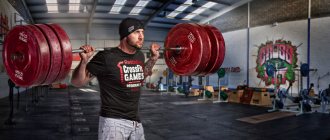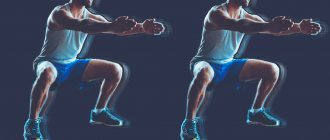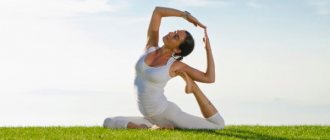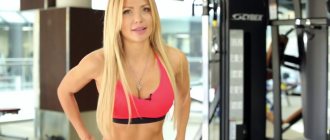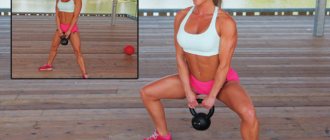Share:
Jump squats are a rather interesting exercise in terms of load, which are deservedly popular among CrossFit and fitness enthusiasts. On the one hand, in it we work out the quadriceps perfectly, working in full amplitude and in an explosive manner, on the other hand, we additionally train our heart, since this exercise also contains aerobic exercise.
Few exercises that do not require the use of additional weights can increase the pace of your workout as much as jump squats. The only things that come to mind are various variations of burpees (with jumping onto a box, jumping over a barbell, pulling up on a horizontal bar, etc.). The work is really colossal: due to the fact that we work non-stop, without giving our muscles a rest, the body does not have time to restore ATP reserves, glycogen reserves in our muscles are quickly consumed, the maximum number of muscle fibers, both fast and slow, and the heart rate can easily reach 140-160 beats per minute, so people suffering from arterial hypertension or other problems with the cardiovascular system should perform this exercise with great caution - such an intense load may be for them excessive and dangerous.
In our article today we will look at the following features of this exercise:
- What are the benefits of jump squats?
- Technique for performing the exercise;
- CrossFit complexes containing this exercise.
What muscles work?
Jump squats work your entire body, from your heels to your crown. In addition to the need to control the correct technique for performing a squat, the athlete must monitor balance. Balance helps to maintain the correct position of the torso during the jumping process. Thus, not only the target muscles work, but also stabilizer muscles, arms, etc.
So, let's list which muscles work when performing jump squats:
- Gluteus maximus muscle;
- Quadriceps;
- Rear and inner thighs (biceps and adductors);
- Calf muscles;
- Press;
- Back and arms.
Jumping options with weights
You can make the exercise more difficult by adding weights. Most people use dumbbells, barbell plates, and sandbags. A barbell on your back as an option for additional weights is only for those who are trained and know how to maintain balance.
It is important not to overdo it with the amount of weights. It is necessary to maintain a balance between a reasonable load on the muscles and the effectiveness of the exercise. Most men should start with weights no heavier than 20 kg, women - 5-12 kg.
Jumping with dumbbells
Technique
- Light dumbbells are picked up and lowered to the sides along the body;
- The athlete lowers himself into a squat according to the general rule - the knees are aligned with the toes, the squat is deep, the pelvic bones pass the level of the knees;
- The jump occurs from the bottom point, the hands firmly hold the dumbbells;
- Particular attention should be paid to both the position of the hands when landing and the point at which the descent itself will occur. Use only the front of your arch as a landing point;
- Repeat as many times as necessary. Increase weight as your strength increases.
With pancake
The barbell plate can be held in two positions. In weightlifting, it is sometimes pressed against the forehead, held with the hands in front of the face. This position is for those who cannot keep their back vertical and lower themselves as if “pulling back” their buttocks. The second - classic - with crossed arms in front of the chest.
With sandbag
There are two options here - either the bag is held in front of the chest, or in a position on the back, it all depends on the weight and size of the bag.
With a barbell
It is performed almost like a classic squat with a barbell. The projectile is taken from the racks, the athlete steps away from them, removing the barbell, and lowers into a squat, and then jumps up. Some athletes perform this exercise with a front hold and with the barbell overhead. But such variations are recommended only for those who have excellent coordination of movements. The option with a barbell overhead is quite dangerous due to the shock load on the arms and shoulders, and therefore should not be used in fitness
The benefits and harms of exercise
Here are the benefits of jump squats:
- Exercise increases the tone of the muscles of the thighs, buttocks, abs, and tightens the skin;
- Helps to form a beautiful muscle relief;
- Strengthens the cardiovascular system;
- Actively starts the fat burning process;
- Strengthens the muscle corset, helps improve the sense of balance;
The squat-jump exercise is very effective, especially in interval or circuit training, where cardio is combined with strength training. Please note that there are a number of contraindications in which jumping out of a squat is strictly prohibited.
As we have already said, the exercise belongs to the explosive category - it is performed at a fast pace, powerfully, often in jerks (for example, explosive push-ups with a clap behind the back). It is difficult for an athlete to control the correct position of the body in space, so it is important to thoroughly study and practice the technique. Otherwise, there is a high risk of injury to the knees or spine.
Contraindications include:
- Exacerbations of any chronic diseases;
- Diseases of the heart and respiratory system;
- Conditions after stroke, heart attack;
- Any inflammation, including increased body temperature;
- Poor health (weakness, migraine, headache, blood pressure);
- After abdominal operations;
- Diseases of the leg joints or musculoskeletal system;
- Any conditions incompatible with physical activity.
Advantages
The squat jump uses both your lower body and core muscles: your abs, glutes, hamstrings, and lower back. The squat jump occupies one of the leading positions among exercises for developing explosive strength using only the athlete’s own weight. Performing plyometric exercises is mandatory included in the training program when preparing for those sports that require short-distance running: football, baseball, track and field. Numerous studies have found that the squat jump improves sprinting performance because both of these exercises require explosive muscle power.
Squat jumps are also beneficial for children aged 5 years and older to develop running and kicking skills, as well as balance and agility.
Execution technique
Let's look at the correct technique for doing a jump squat:
- Starting position – as for classic squats. Feet shoulder-width apart, arms straight along the body, look forward, back straight, knees and toes pointing in the same direction;
- As you inhale, lower yourself down until your thighs are parallel to the floor, forming a 90-degree angle with your knees;
- As you exhale, jump powerfully straight up, reaching for the ceiling with the top of your head;
- Return to the squat position with your knees at 90 degrees;
- Continue jumping at a comfortable or set pace.
Preparation for execution
Preparing to perform is similar to what we do when we squat with a weight. Start with a few minutes on an exercise bike or elliptical ergometer to raise your body temperature and prepare your joints for work. Then - full-fledged articular gymnastics, flexion and extension in all major joints of the body. Afterwards – several sets of regular squats, without jumping. If there are problems with the joints, start not at full amplitude, and continue, increasing the amplitude.
If there are no problems with the joints, you can start jumping with 2-3 approaches. For those who perform weighted jumps, it is recommended to first squat with 2/3 of this weight to the full amplitude.
Plyometrics are quite demanding when it comes to warming up. If the movements are performed outdoors, for example, before jogging, then the number of warm-up approaches should be increased by another 2-3.
Features of the technique and common mistakes
The absence of errors guarantees high performance and minimal risk of damage to the athlete’s health.
- When squatting, control the position of your foot - it should not leave the floor at the heel;
- Never round your back. Imagine that they drove a stake into the top of your head, which went through your whole body and came out somewhere in the area, excuse me, butt. Just jump like that. In this case, the body can be slightly tilted forward, allowing the body to intuitively choose a comfortable position.
- The shoulders are kept lowered, the neck is relaxed, the shoulder blades are slightly brought together, the arms are tense and lie along the body. Don't wave them around or let them dangle uselessly. You can take small dumbbells - this will increase the load and keep your hands busy.
- To protect your joints, land softly, pretending there are springs on your soles. Hard and impact jumps can cause sprains or dislocations;
- During the squat, do not bend at the lower back;
- Make sure that your knees do not go beyond the plane of your toes;
- Always land with your legs bent.
First of all, carefully practice the technique of performing jump squats. At first, it is recommended to perform the exercise slowly, without rushing. Listen to your body, feel if your muscles are resisting.
High jump squats have the greatest effect when performed at a high tempo. For beginner athletes, 10-15 jumps in 3 sets are enough, with a break of 30-60 seconds. Strive to regularly increase the load, increase the number of repetitions to 30-40, and approaches to 5-6.
Execution options
You can make this exercise easier or more difficult just by changing it up a little.
Are changes needed?
Jump and then press your knees to your chest, it's not that easy. First, learn a simple squat jump technique, and then practice bringing your knees to your chest.
Decide what is more important to you: speed or height. If you want to focus on speed, your jump height will definitely suffer. If the power of the jump is primarily important to you, then don’t rush.
Squat jumps without tuck can be performed by children aged 5 years and older. Children are recommended to do 50-60 jumps per workout, twice a week for 8-10 weeks. If children do not have a penchant for jumping exercises, and training is difficult, then simply use a low-intensity program, but for a longer period.
Changes
After you have mastered jumping from a stationary state, try jumping onto a step or low bench, no more than 15 cm high. Jump, pause, then take a step down and repeat the exercise.
You can use squat squats to add high-intensity intervals to your workout. Perform jumps without rest for the required interval.
To develop lower back strength, use the isometric version. As you squat, pause and squeeze your front thighs and glutes before jumping.
Jump Squat Variations
- In addition to the classic jump up, advanced athletes perform squats with a side jump. This option requires increased control over the position of the body in space.
- If you want to make the task more challenging, use weights such as dumbbells.
- Also, you can try not just jumping, but jumping onto a small elevation.
- Experienced athletes use so-called “ligaments”: they do a squat, touching their palms to the floor, suddenly take a lying position, do push-ups, return to a squat, and jump.
The choice of variation, of course, depends on the athlete’s level of training. To begin with, it is recommended to master the classic version with jumping up. As soon as you realize that this load is not enough, feel free to move on to complication. Follow your technique and don’t forget about soft and comfortable sneakers!
Safety
Be sure to consult a doctor before performing the exercise, because if you have injuries or diseases of the legs, back or neck, this exercise should be avoided. Also, squat jumps are not recommended for pregnant women, because their center of body mass changes and the effect of hormones on the joints is observed.
If you have no contraindications, then perform squats every 48-72 hours so that your body has enough time to recover. Make sure the surface on which you exercise is non-slip. Keep pets and small children away while you exercise.
Description of the exercise
What is a burpee in sports? It is a CrossFit exercise consisting of a sequence of squats, push-ups and jumps. The workout gives athletes cardio, develops strength and endurance. A lot of energy is burned in 10 minutes.
For the classic burpee, you don't need sports equipment, only your own body. In complex versions, jumping pedestals, pull-up bars, and dumbbells are used.
